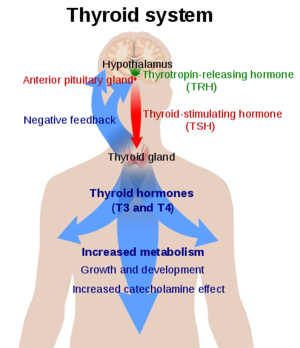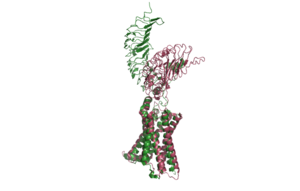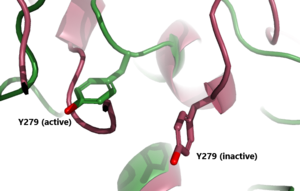Sandbox Reserved 1792
From Proteopedia
(Difference between revisions)
| Line 6: | Line 6: | ||
== Introduction == | == Introduction == | ||
| - | [[Image:Thyroid System.png|300 px|right|thumb|An overview of the Thyroid System source: [https://en.wikipedia.org/wiki/Thyroid_hormones Thyroid Hormones]]] | + | [[Image:Thyroid System.png|300 px|right|thumb| Fig.1 An overview of the Thyroid System source: [https://en.wikipedia.org/wiki/Thyroid_hormones Thyroid Hormones]]] |
| - | '''Thyroid Stimulating Hormone Receptor (TSHR)''' is a type of [https://proteopedia.org/wiki/index.php/GPCRs G-Protein Coupled Receptor (GPCR)] found in human thyroid follicles. It is activated by the [https://en.wikipedia.org/wiki/Thyroid-stimulating_hormone Thyroid Stimulating Hormone (TSH)] which is known as thyrotropin. Activation of TSHR is neccessary for activating a signaling pathway for the production of thyroid hormones such as [https://en.wikipedia.org/wiki/Triiodothyronine T<sub>3</sub>] and [https://en.wikipedia.org/wiki/Thyroid_hormones T<sub>4</sub>] | + | '''Thyroid Stimulating Hormone Receptor (TSHR)''' is a type of [https://proteopedia.org/wiki/index.php/GPCRs G-Protein Coupled Receptor (GPCR)] found in human thyroid follicles. It is activated by the [https://en.wikipedia.org/wiki/Thyroid-stimulating_hormone Thyroid Stimulating Hormone (TSH)] which is known as thyrotropin. Activation of TSHR is neccessary for activating a signaling pathway for the production of thyroid hormones such as [https://en.wikipedia.org/wiki/Triiodothyronine T<sub>3</sub>] and [https://en.wikipedia.org/wiki/Thyroid_hormones T<sub>4</sub>]Fig 1. |
== Structure== | == Structure== | ||
TSHR forms a complex with TSH and G<sub>s</sub> proteins. This is called the <scene name=scene name='95/952720/Tsh-tshr-gs_complex/3'>TSH-TSHR-Gs Complex</scene>. | TSHR forms a complex with TSH and G<sub>s</sub> proteins. This is called the <scene name=scene name='95/952720/Tsh-tshr-gs_complex/3'>TSH-TSHR-Gs Complex</scene>. | ||
| Line 14: | Line 14: | ||
<scene name='95/952720/Transmembrane_region_spin/5'>The Transmembrane Region</scene> (<scene name='95/952720/Transmembrane_region_top-view/2'>top-view</scene>) is embedded within the cell membrane. Like other G-protein receptors, it is made up of a 7-pass helix <ref name="Faust"> DOI 10.1038/s41586-022-05159-1</ref>. The transmembrane region is surrounded by a "belt" of <scene name='95/952720/Tmd_cholesterol_spin/2'>15 cholesterols</scene>. When cholesterol binding sites are mutated such that they are unfunctional, TSHR activity decreases. Thus, the cholesterols are important for TSHR function (reference). Additionally, at the N-terminus, the transmembrane region binds to the <scene name='95/952720/Transmembrane_region_spin/4'>G-proteins</scene>. | <scene name='95/952720/Transmembrane_region_spin/5'>The Transmembrane Region</scene> (<scene name='95/952720/Transmembrane_region_top-view/2'>top-view</scene>) is embedded within the cell membrane. Like other G-protein receptors, it is made up of a 7-pass helix <ref name="Faust"> DOI 10.1038/s41586-022-05159-1</ref>. The transmembrane region is surrounded by a "belt" of <scene name='95/952720/Tmd_cholesterol_spin/2'>15 cholesterols</scene>. When cholesterol binding sites are mutated such that they are unfunctional, TSHR activity decreases. Thus, the cholesterols are important for TSHR function (reference). Additionally, at the N-terminus, the transmembrane region binds to the <scene name='95/952720/Transmembrane_region_spin/4'>G-proteins</scene>. | ||
| - | === Hinge Region=== | ||
| - | The <scene name='95/952720/Hinge_region_spin/1'>Hinge Region</scene> (purple-blue) connects the Transmembrane Region to the Leucine Rich Domain. It is made up of two α-helices that are connected via di-sulfide bonds(shown in yellow). Interactions between these two helices and TSH help orient TSH properly. These interactions are essential for TSH binding, however, they are not required for the activation of TSHR. Conformational changes in this region, specifically the orientation of <scene name='95/952720/Hinge_region_residues/2'>Y279 residue</scene>, are responsible for the bringing TSHR into the active state <ref name="Faust"/> | ||
=== Leucine Rich Domain=== | === Leucine Rich Domain=== | ||
The <scene name='95/952720/Lrrd/1'>Leucine Rich Repeat Domain (LRRD)</scene> is part of the extracellular region of TSHR. Connected to its C-terminus is the Hinge Region. It is made up of an extensive parallel β-sheet. This β-sheet is where TSH binds and is called the binding pocket<ref name="Duan"> DOI 10.1038/s41586-022-05173-3</ref>. | The <scene name='95/952720/Lrrd/1'>Leucine Rich Repeat Domain (LRRD)</scene> is part of the extracellular region of TSHR. Connected to its C-terminus is the Hinge Region. It is made up of an extensive parallel β-sheet. This β-sheet is where TSH binds and is called the binding pocket<ref name="Duan"> DOI 10.1038/s41586-022-05173-3</ref>. | ||
| - | === | + | === Hinge Region=== |
| + | The <scene name='95/952720/Hinge_region_spin/1'>Hinge Region</scene> (purple-blue) connects the Transmembrane Region to the Leucine Rich Domain. It is sometimes referred to as the signaling specificity domain because there is some evidence suggesting that this region is important in both TSH binding and signal transduction. <ref name="Chen">Chen CR, McLachlan SM, Rapoport B. Thyrotropin (TSH) receptor residue E251 in the extracellular leucine-rich repeat domain is critical for linking TSH binding to receptor activation. Endocrinology. 2010 Apr;151(4):1940-7. doi: 10.1210/en.2009-1430. Epub 2010 Feb 24. PMID: 20181794; PMCID: PMC2851189. [DOI 10.1210/en.2009-1430 https://www.ncbi.nlm.nih.gov/pmc/articles/PMC2851189/]</ref>. It is made up of two α-helices that are connected via di-sulfide bonds(shown in yellow). Interactions between these two helices and TSH help orient TSH properly. These interactions are essential for TSH binding, however, they are not required for the activation of TSHR. Conformational changes in this region, specifically the orientation of <scene name='95/952720/Hinge_region_residues/2'>Y279 residue</scene>, are responsible for the bringing TSHR into the active state <ref name="Faust"/> | ||
== Active vs Inactive State== | == Active vs Inactive State== | ||
Revision as of 16:58, 7 April 2023
| This Sandbox is Reserved from February 27 through August 31, 2023 for use in the course CH462 Biochemistry II taught by R. Jeremy Johnson at the Butler University, Indianapolis, USA. This reservation includes Sandbox Reserved 1765 through Sandbox Reserved 1795. |
To get started:
More help: Help:Editing |
Thyroid Stimulating Hormone Receptor (TSHR)
| |||||||||||
References
- ↑ Hanson, R. M., Prilusky, J., Renjian, Z., Nakane, T. and Sussman, J. L. (2013), JSmol and the Next-Generation Web-Based Representation of 3D Molecular Structure as Applied to Proteopedia. Isr. J. Chem., 53:207-216. doi:http://dx.doi.org/10.1002/ijch.201300024
- ↑ Herraez A. Biomolecules in the computer: Jmol to the rescue. Biochem Mol Biol Educ. 2006 Jul;34(4):255-61. doi: 10.1002/bmb.2006.494034042644. PMID:21638687 doi:10.1002/bmb.2006.494034042644
- ↑ 3.0 3.1 3.2 Faust B, Billesbolle CB, Suomivuori CM, Singh I, Zhang K, Hoppe N, Pinto AFM, Diedrich JK, Muftuoglu Y, Szkudlinski MW, Saghatelian A, Dror RO, Cheng Y, Manglik A. Autoantibody mimicry of hormone action at the thyrotropin receptor. Nature. 2022 Aug 8. pii: 10.1038/s41586-022-05159-1. doi:, 10.1038/s41586-022-05159-1. PMID:35940205 doi:http://dx.doi.org/10.1038/s41586-022-05159-1
- ↑ Duan J, Xu P, Luan X, Ji Y, He X, Song N, Yuan Q, Jin Y, Cheng X, Jiang H, Zheng J, Zhang S, Jiang Y, Xu HE. Hormone- and antibody-mediated activation of the thyrotropin receptor. Nature. 2022 Aug 8. pii: 10.1038/s41586-022-05173-3. doi:, 10.1038/s41586-022-05173-3. PMID:35940204 doi:http://dx.doi.org/10.1038/s41586-022-05173-3
- ↑ Chen CR, McLachlan SM, Rapoport B. Thyrotropin (TSH) receptor residue E251 in the extracellular leucine-rich repeat domain is critical for linking TSH binding to receptor activation. Endocrinology. 2010 Apr;151(4):1940-7. doi: 10.1210/en.2009-1430. Epub 2010 Feb 24. PMID: 20181794; PMCID: PMC2851189. [DOI 10.1210/en.2009-1430 https://www.ncbi.nlm.nih.gov/pmc/articles/PMC2851189/]
Student Contributors
- Alex Kem
- Grace Lane



